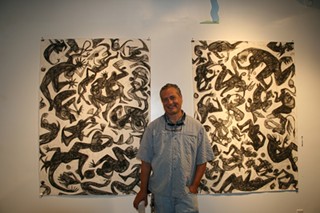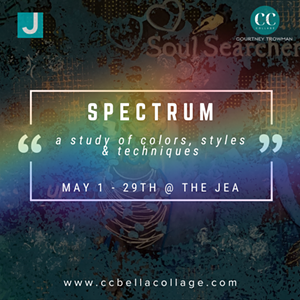As the crowd grew at the Indigo Sky Community Gallery on a recent Friday evening to view the new group of drawings by Morgan Santander, they repeatedly heard the words rhythmic, indigenous, hidden, figural, and symbolic.
A native of Mexico, Santander comes with a big resume of degrees from UC Berkeley and University of Chicago, international exhibitions, a large number of works in collections throughout the world, and, most recently, a 12-year teaching gig at SCAD. He's now off to Puerto Rico and then Asheville, N.C. where he will continue to expand his oeuvre.
His main body of work consists of brightly colored, often representational, canvases. This group of drawings at Indigo Sky is a departure from this vibrant body of work in that they are charcoal on paper, conveying a simple, yet somewhat somber mood.
At first glance, each work appears to be an overall abstraction, or composed of what Clement Greenberg would have called "pure form."
My dearly departed friend and mentor, Tom Hoving, who was a great art historian and the revolutionary director of New York's Metropolitan Museum, taught me an exercise for looking at works of art. He said that the first glance is the truest, the most powerful, and it should be given quickly. Then immediately look away and examine your gut reaction. If it is strong, then dive into the details. Santander's works certainly drew many into the details.
We all love to see "something" in abstract art. When I was an art dealer representing a great abstract expressionist painter, my clients would always ask what was "in" the works, vainly searching for representation, never being content with abstract form and color. It is just too unsettling for some people.
Well, Santander's drawings allow the viewer to have his abstraction and see his signs too. Deepening the viewer's experience through a few of the works, Santander provided laser light pointers so that viewers can follow the white spaces around the forms as mazes.
And they work! This interactivity is something Santander is continuing to explore and gleefully talks about what informs his work:
"This group is unique as a body of work for me because it is charcoal and paper. You cannot hide. Drawing is pure. There is no trickery of painting."
He explained that in some ways, he is getting back to foundational elements of art like drawing and the exploration of the human figure. The figures are recognizable up close as somewhat human, however, they are mutant, imperfect, and fantastical. Literature has always informed Santander's works, and he cites Kafka's Metamorphosis as the guiding influence of these drawings.
"I love the idea of continuous change and tumultuous times. These are tumultuous times," he said.
Figures appear with human bodies and jester-like heads. Some have happy trumpets for noses, and others are becoming elephants. Eyes slowly pop out from deeper layers. Words are embedded in the works as well and one recognizes words such as "lost," "Teo," and "Gregor."
Gregor is the main character in Kafka's Metamorphosis who, for no particular reason, is transformed from a salesman into a giant insect. At this stage of examination, the viewer is deep into the work that now calls us to make our own stories, yet none of them are clear. What is clear, as the figures jumble, turn, and fall through space, is that these are pictures of an uncertain world.
Music also informs Santander's works and his rhythmic compositions indeed resonate with a kind of tribal backbeat and a plucky guitar. (He also plays flamenco guitar.) Backing away again to a distance, the drawings do vibrate with a mysterious, almost indigenous, aura.
The magic of Santander's drawings is that they are somehow joyful renditions of an uncertain world. It feels okay to not know exactly what we are looking at, yet the more one looks, the more one sees, even backing away, and gazing from a distance.

























